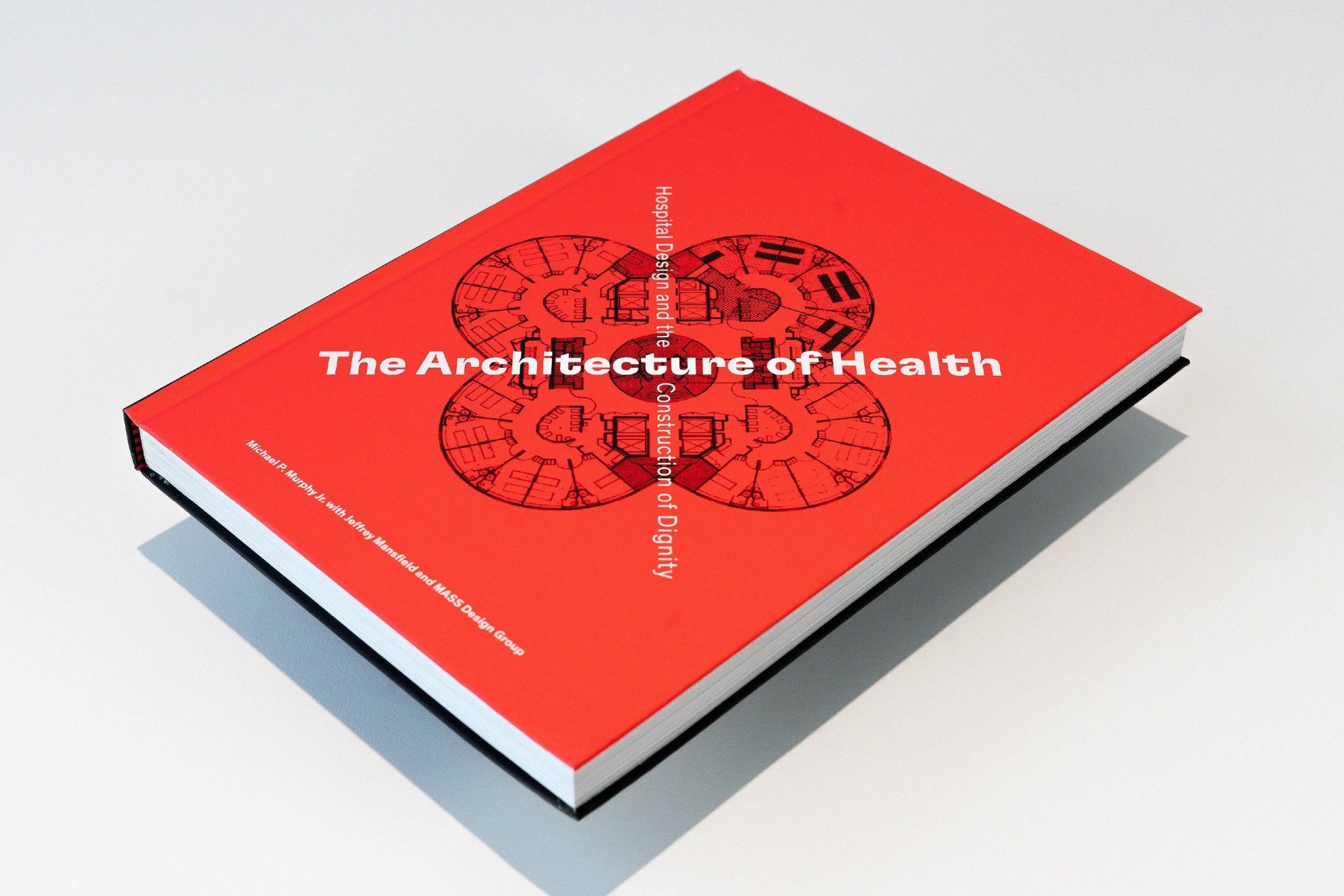New Book from Mass Design Group’s Michael Murphy Presents the History of Hospital Architecture Offering Essential Considerations for Future Building

Cooper Hewitt, Smithsonian Design Museum publishes the “The Architecture of Health,” and hosts a related exhibition on the evolution of healthcare architecture and design
BOSTON, OCTOBER 5, 2021
While combating the COVID-19 pandemic, the public has asked architects why our buildings make us sicker. A new book authored by Founding Principal and Executive Director Michael P. Murphy, Jr. with Design Director Jeffrey Mansfield and MASS Design Group explores this question and unearths how the architecture around us has been influenced by developments in healthcare. The Architecture of Health examines how our built world was shaped by disease and reveals how historical examples can offer us caution and inspiration.
“At some point, facing tragedy or joy, most of us will spend days, if not weeks, in a hospital, coping with the existential realities of birth and death,“ said Michael Murphy. “Hospitals, and architecture, can both impede and advance our collective rights — such as the right to healthcare or the right to breathe — but must fulfill our most elemental right, the right to dignity.”
The Architecture of Health posits that a historical analysis of hospitals is essential to understanding their architectural function in the present. Pamela Horn, the director of cross-platform publishing at Cooper Hewitt writes, this book “charts historical epidemics alongside modern and contemporary architectural transformations in service of medicine, health, and habitation; it explores how infrastructure facilitates healing and architecture’s greater role in constructing our social order.”
Murphy, Mansfield, and MASS, gathered research from over a decade of work in global healthcare design. In their findings, it became clear that the rapidly evolving nature of medicine has dictated building practices, and thus design. The book linearly shows that though architecture has always played a role in hospital design, housing machinery came to take precedence over patient experience and personal dignity. The Architecture of Health reveals how looking back at natural systems design and community immersion can offer ways to design forward.
This book intends to show, through hospital design, that architecture’s larger impact on society is clear and inseparable. Hospital design has been historically underrepresented in the critical theory of architecture, seen as a subdiscipline of study—or worse—an overly wrought category of building type. While the historical and contemporary debate continues as to whether architecture can influence social or physiological change, hospitals provide a definitive counterpoint to demonstrate that the behavior and health of individuals are shaped by the design of spaces around them. This historical review of modern health care will aid future generations of architects to interpret and examine how design, and redesign, can impact public health outcomes, social change, and the aspiration towards greater aims in the construction of dignity in the human condition.
“It is crucial to understand how our public buildings serve us, and how in the future such buildings can offer not only a space to heal but a place of beauty and dignity,” said Murphy.
Looking at the buildings and design of our health care system at present, lessons have emerged about the fundamental value of access to breathable, clean air. “The challenge of hospital design is to maintain a space of atmospheric exclusivity that is nonetheless available to all,” writes Dan Barber (Chair of the Graduate Group in Architecture, University of Pennsylvania Stuart Weitzman School of Design) in his introduction to the book.
In 2020 it became apparent that design can have a negative impact on healing if it cannot adapt to public needs, especially in a time of crisis. A pattern is laid bare: that buildings rigidly designed to solve one function may not be able to adapt when there is a tidal shift in healthcare needs. With the onset of the COVID-19 pandemic, that shift was suddenly upon the world. If the pandemic has taught us anything about the buildings where we are meant to heal, it has most often revealed their flaws.
The book urges us to ask: Why have the designs in our healthcare facilities failed us so frequently? How can the spaces around us be designed to improve and better serve our health and society? And finally, when our collective health has been compromised, can the lesson in solving for our right to breathe offer a vision forward?
Available for pre-order now and shipped in November 2021, the book is being published by Cooper Hewitt, Smithsonian Design Museum and distributed by Artbook | D.A.P. The book complements a new exhibition at the museum, “Design and Healing: Creative Responses to Epidemics,” which opens in December 2021.
Recent Press:
-
When you think of hospitals, you think of hallways. Here’s why we designed a hospital without them
Fast Company, January 3, 2022 -
MASS Design's Michael Murphy says we're failing to learn the epidemic design lessons Florence Nightingale provided 150 years ago
Archinect, December 29, 2021 -
Favorite Architecture Books of 2021
ArchiECHO, December 22, 2021 -
Can Architecture and Design Facilitate Healing?
Metropolis, December 21, 2021 -
The secret to hospital design was solved 150 years ago. Why did we ignore it?
Fast Company, December 20, 2021 -
Books for Your Holiday Gift List
Architectural Record, December 16, 2021 -
Michael Murphy on the Architecture of Health
Common Edge, December 14, 2021 -
Virtual Book Talk: The Architecture of Health with Michael Murphy and Michael Kimmelman
Cooper Hewitt, December 14, 2021
